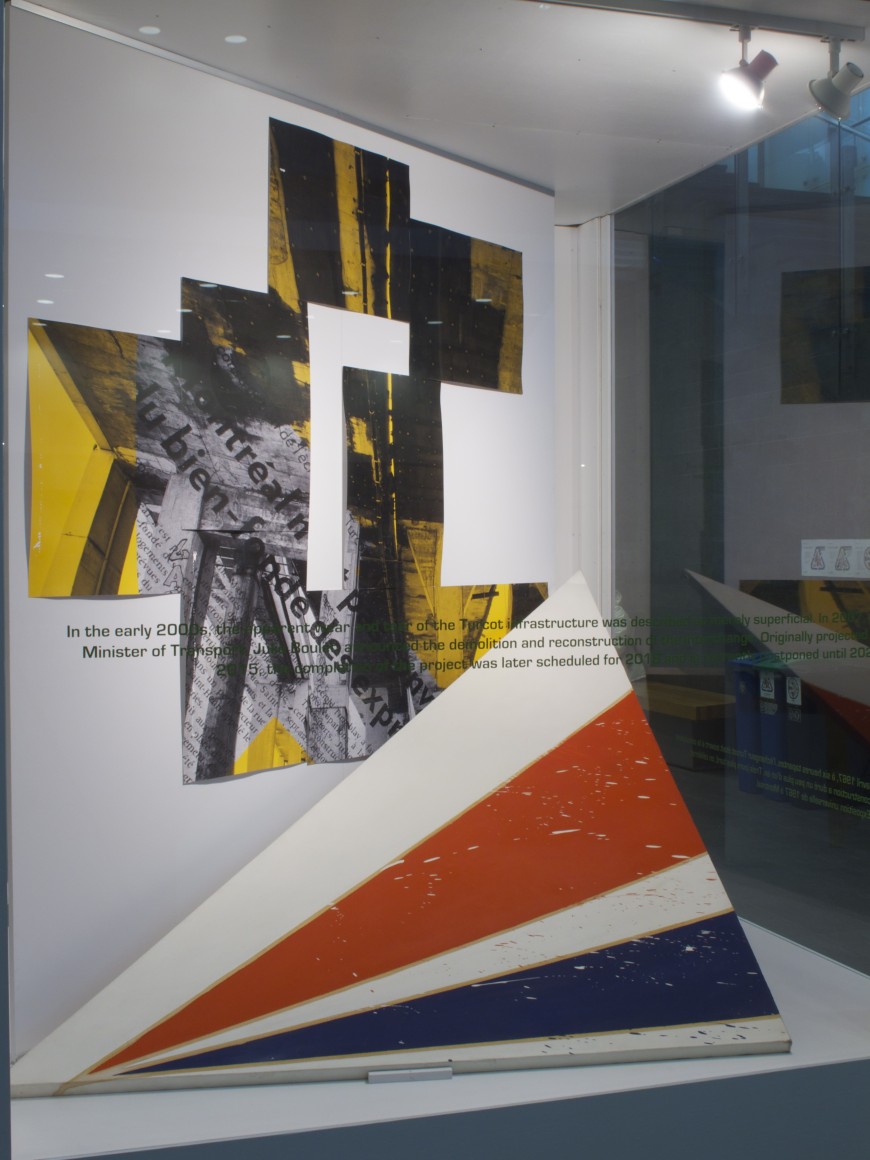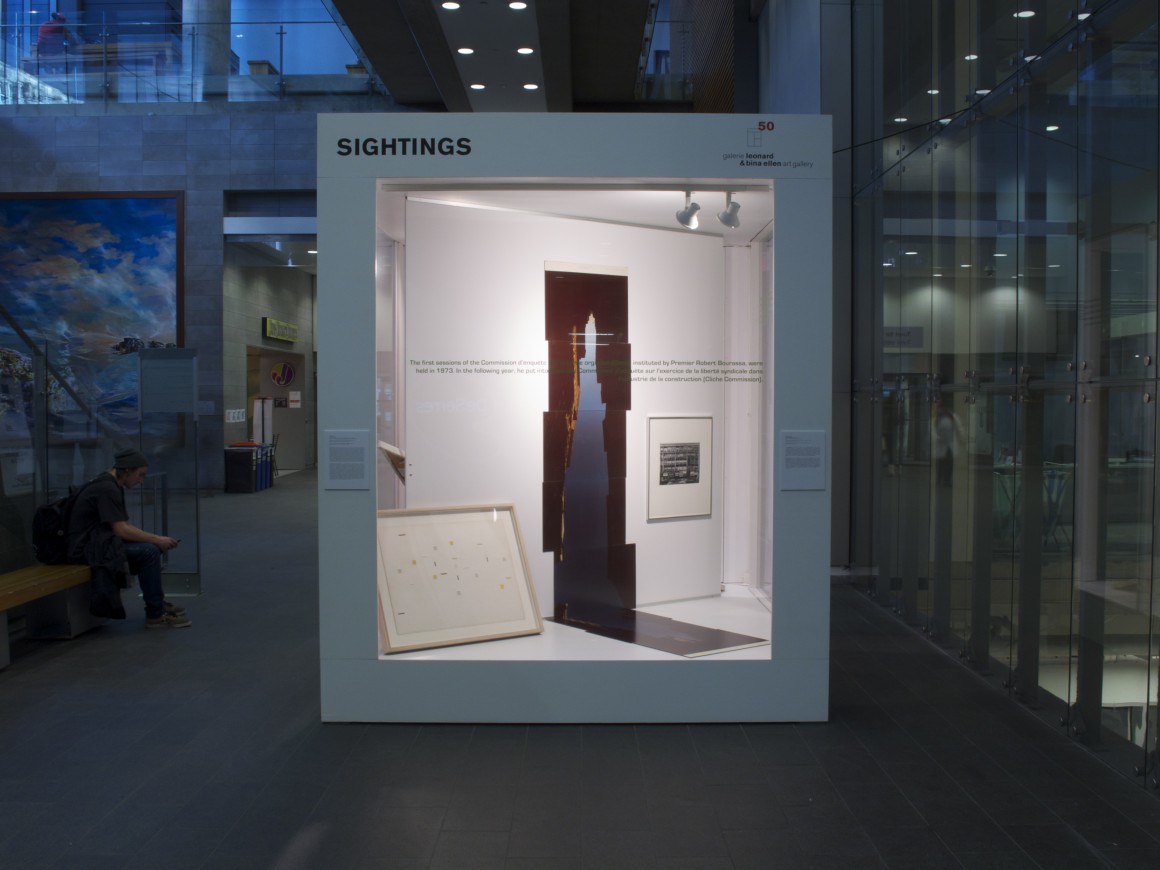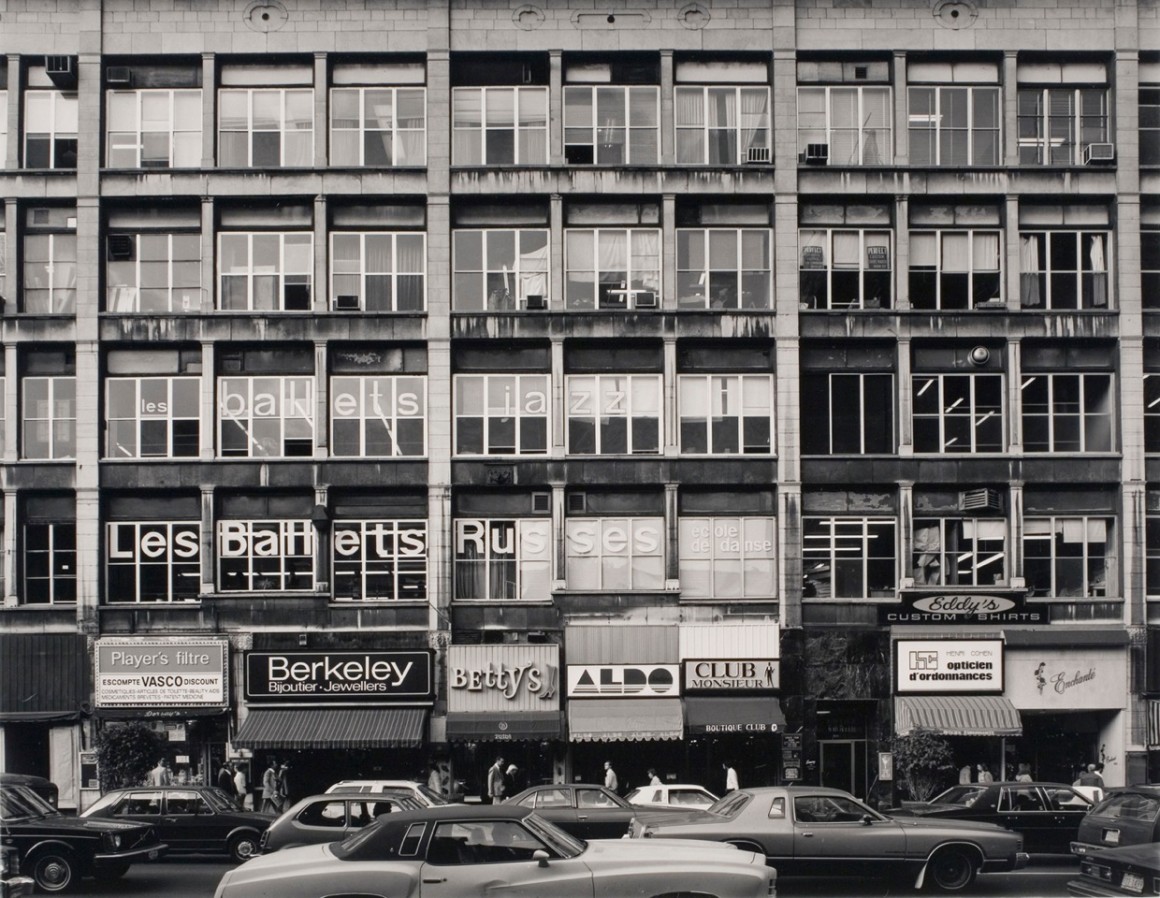November 29, 2012 – February 17, 2013
A project by Étienne Tremblay-Tardif
With artworks by Pierre Boogaerts, Yves Gaucher, Serge Lemoyne and Gabor Szilasi
SIGHTINGS V. The Shaped Canvas and the Highway Interchange as Case Studies embodies Étienne Tremblay-Tardif’s interest in urban space, the Turcot Interchange, the world of construction in Montreal, formalist grids in the visual arts field, and the shaped canvas. Within this context, he juxtaposes four artworks from the sixties and seventies by major Québécois artists with one of his own artworks in order to instigate critical thinking around both architectural and pictorial spaces.
Étienne Tremblay-Tardif, who moved to Montreal in 2004, is an artist from Isle-aux-Coudres in the Charlevoix region. His art practice is implicity marked by regionalist landscape painting and the cinema of Pierre Perreault’s, which act for him as a family album. Paintings and films offer his work historical markings, reference points for the beginning and end of Quebec modernity, and propose a notion of place as cultural and political territory. He is currently completing a Master’s degree in visual arts in Concordia University’s print media program. Tremblay-Tardif holds two bachelor’s degrees: one in art history and film studies and the other in visual arts. Since 2007, he has received the Prix Albert-Dumouchel, a Hydro-Québec graduate studies scholarship, and a master’s degree scholarship from SSHRC. In spring 2011, he participated in the group exhibition, Ignition 7, at the Leonard & Bina Ellen Gallery, and in August 2012, he began the Hôpital Maxime-le-Jaune project during the Symposium international d’art contemporain de Baie-Saint-Paul. This fall, he had a solo exhibition, Bookworms, at Arprim.
Read more
SIGHTINGS V:The Shaped Canvas and the Highway Interchange as Case Studies.
To this day, the shaped canvas as trope is presented as an issue in the history of painting. Certainly, the shaped canvas marks an ambiguous pictorial relation to space and its delimitation – and more precisely, to architecture. The prototypes or models possibly represented by medieval altarpieces, Renaissance tondos, and Baroque mises en scène seem to point toward a pictoriality that is anchored in an architectural space and seeks to occupy, construct, or extend it. A similar impetus seems to guide constructivist counter-reliefs and other experiments. The critical acclaim for Robert Rauschenberg’s combines also points in this direction – to a trend toward a performative configured space, happenings, and relations among social bodies. Yet, if we extend the list to include, for example, Frank Stella’s black shaped canvases or, in Quebec, works by Claude Tousignant and Serge Lemoyne in the wake of the early Plasticiens, this trend seems to be reversed: from pictorial expansion, there is a transition to a sort of compression of space toward the surface of the painting. It is as if, to maintain a tension on the pictorial level, the forces operating on the normally rectangular definition of the painting either sprang up and spread out or collapsed and withdrew.
It seems to me that this double movement of expansion and compression is, today, an interesting avenue for instigating critical thought on what is already promising to be the biggest construction project in contemporary Quebec: the reconstruction of the Turcot interchange and surrounding highway complex. The clashing of a number of ideological visions around this major urban planning issue for the Montreal of the future, in the current social context of re-evaluation of political structures and radicalization of cynicism and social commitment, is reminiscent of the late 1960s and early 1970s, when the Turcot interchange was first built and the Commission of Inquiry into Organized Crime (CIOC) was instituted. In fact, this moment is filmmaker Denys Arcand’s focus in his film, Réjanne Padovani (1973), which propels viewers into a retro-futurist science fiction world in which activism, ambition, avarice, speculation, omertà, and corruption are played out against the background of the completion of the last ramps of an unnamed highway interchange. From construction to ruin, from ruin to dismantlement and reconstruction – I no longer know if the interchange is collapsing or exploding with dynamite as it is being dynamited. I propose a model for reconstruction that lies between deployment and flattening, between collapse and explosion.
Translation by Kathe Roth
Pierre Boogaerts (born 1946) is known for his photographic work on the city and architecture situated at the intersection of conceptual strategies and post-minimalist practices. He uses photography as a means of transcription of the urban space – more specifically, in this case, the “horizon line” of New York framed by the monumental presence of skyscrapers on 25th Street. Through this process, he creates pictorial surfaces with complex geometries, whose contours may represent “X,” “T,” or columnar shapes. A back-and-forth is formed between an image of the real as captured by the device for photographic recording, thus informing the composition of the photographic polyptych, and the experience of the stroller and the artist in the urban space of Manhattan. In Boogaerts’s work, the notions of flattening and compression are contiguous to those of expansion and deployment.
Serge Lemoyne (1941–1998) was first active within multidisciplinary groups such as L’Horloge, Zirmate, and Semaine A. Most of the time, he acted as organizer and leader of these collectives and of happenings that came to be described as the very first in Canada. The shaped canvas presented here is part of the Pointe d’étoile series of triangular paintings – a series inscribed in the broader corpus that Lemoyne devoted to the Montreal Canadiens. Although it is not anomalous in Lemoyne’s body of work, this series remains a rare example of his almost classic use of the shaped canvas as a modernist trope. It seems to advance a formal strategy developed in the “portraits” of hockey teams’ star players – especially those where the frame is tightened as much as possible – a strategy in which the colour planes are in extreme tension with the perimeter of the painting. The choice of the triangular form further accentuates the impression of fragmentation or truncation of the image and essentially helps negate the pictorial border between representation and abstraction. Between post-Plasticien painting and Pop Art, Serge Lemoyne seems to ferry back and forth between art and life.
Yves Gaucher (1943–2000) formed, with Guido Molinari and Claude Tousignant, the core of the second wave of Montreal Plasticiens. Of these three artists, Gaucher had the most atypical career and used the sparsest visual language: horizontal or vertical bands, lines suggesting movement, chromatic flat fields, complex geometric shapes, diamond-shaped formats. Two elements are specific to his practice: on the one hand, the avowed influence of minimalist or serial music on some works defined by a strategy of transcription that flirts with conceptualism (Hommages à Webern); and, on the other hand, the contribution of etching techniques and printmaking tradition. Pli selon pli offers a perfect example of opposing tensions in his use of intaglio and relief, on the pictorial plane. Whereas the definition of the plane remains rectangular, the embossing of the paper echoes the bas-relief as a buffer zone between the fields of architecture, sculpture, and painting. Yves Gaucher would perhaps only go once beyond the rectangular confines of the canvas when he participated in the project, Painting the Town, organized by ManuVie. Consisting of seven works on large-scale out-door panels painted by artists, the exhibition would travel to ten Canadian cities. Featuring a trapezoidal form emerging from the upper edge of the panel, Gaucher’s work, M.L.S.P. I/II 87, was presented on Rosemont Boulevard and St-Hubert Street during the exhibition’s presentation in Montreal.
Gabor Szilasi (born 1928) has extensively documented the territory of Quebec. Although the portrait genre is very important to his practice, he has also produced numerous rural Quebec landscapes – either on his own account between teaching contracts or through institutional commissions, as was the case for the construction sites of Expo 67, at which time he photographed the brand-new Turcot interchange. King’s Hall Building, rue Sainte-Catherine Ouest, Montréal is among some 150 shots of retail façades on St. Catherine Street. A bold modernist grid where the concrete formwork emerges into the foreground in relation to the glass curtain-wall, dissolves at the bottom of the image within the flow of automobile and pedestrian traffic and the signage strategies of the commercial strip. This principle of iconicity has been skilfully theorized and defended by architects, Denise Scott Brown and Robert Venturi. In their view, architecture must be understood above all as surface, a support for media, rather than as volumetrics.
References
Beaulieu, Simon, et Benjamin Hogue et Christian Laramée, Lemoyne : documentaire sur la vie et l’œuvre du peintre Serge Lemoyne, Montréal, Vidéographe, 2005, 80 minutes.
Dessureault, Pierre et Michel Denée, Pierre Boogaerts : le regard, le réel, l’image, Ottawa, Canadian Museum of Contemporary Photography, Ottawa, 2001.
Grant Marchand, Sandra et al., Yves Gaucher, Montréal, Musée d’art contemporain de Montréal, 2004.
Harris, David, Gabor Szilasi : l’éloquence du quotidien, Joliette, Musée d’art de Joliette, 2009.
Joseph, Branden W., « The Gap and the Frame », October, numero 117, Summer 2006, p. 44-70.
Nasgaard, Roald, Abstract Painting in Canada, Toronto, Douglas & McIntyre, 2007.
Obrist, Hans Ulrich et Rem Koolhaas, « An Interview with Denise Scott Brown and Robert Venturi », Harvard Design School guide to shopping, Cambridge (Mass.), Harvard Design School, 2001, p. 590-617.
CloseThe Leonard & Bina Ellen Art Gallery’s contemporary exhibition program is supported by the Canada Council for the Arts.












